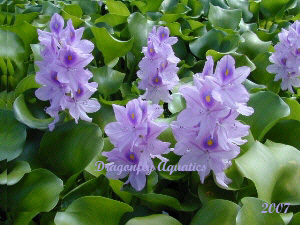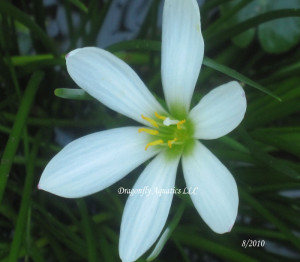Well mother nature looks like she's going to turn things around and start giving us in the north some warmer weather beginning next week. Usually May things start to warm up and it won't be long until we can begin putting out plants in the pond.
A good rule of thumb is always make sure your water temperatures are around 65 degrees before putting in new plants. Think of it like taking a bath in cold water. You'd shiver too and be a little shocked.
Lotus are a master piece in a water garden. Their outstanding flowers and large leaves whether in your pond or container are a beautiful addition to your water garden. Lotus are hardy perennials and will reward you with exotic flowers year after year.
There are small, medium and large lotus. Lotus won't start to appear in the spring until the water temperature warms in the pond which is about 65 degrees. In the colder areas where a lotus has been overwintered at the bottom of the pond, raise the pot so that it is just a few inches below the water surface and it will be warmed by the sun. If you overwintered the lotus in peat for the winter don't place it back in the pond until the water temperatures are 65 degrees. Once the water warms up in the 70s the lotus will start to grow more rapidly. They will begin to flower several weeks later than waterlilies, often not until late July and August in zones lower than 6 and zones earlier than 6 will begin earlier in July. They continue to bloom until late September and October depending on your climate.
So whether you have a large pond or just a small container on your patio a lotus will grow. I would suggest planting it in a large container and put in your pond, otherwise it could grow out of control. Keeping it confined in a container eliminates this. Planting it in a container it only requires a few inches of water over the tuber to grow. So whether you plant a lotus in your pond or simply plant it in a small container and set it on your patio, you will be glad you did.
There isn't much work to grow a lotus but the rewards are spectacular.
HARDY LOTUS
As the lotus leaves begin to turn brown, the lotus is beginning to go dormant for the winter. Do not cut off the leaves; allow them to die back naturally. After they die back at this point, it is safe to cut them off above the water line. Its important to leave a portion of the stem above the water. You do not want water getting down the hollow green stem and having it get into the air channels of the tuber, if this happens you risk drowning the tuber and cause it to rot. Make sure the potted lotus is below the ice. Allowing the tuber to freeze will kill the plant.

Floating plants such as Water Hyacinth and Water Lettuce are considered tropical and will not survive temperatures below freezing. After the first hard frost, remove from the pond to prevent them from decaying and adding unwanted debris to the pond.
Woke up this morning with a chill in the air....gone for a few days are the 80 degree temps. This is what we woke up to this morning.
The leaves are even beginning to fall with the wind blowing. I guess we all know what is in store for us for the next couple months.
Another Red Scarf bud is starting to open in my pond. I find I enjoy the pond plants even more towards the end of the season. It's such a pretty lotus bud.
I probably should get out my sweatshirts and sweaters now. I love fall with its beautiful colors when the leaves begin to turn but don't look forward to what comes after....snow. There are a few things we can start doing to our ponds now since the days are numbered. Here's a list of some fall and winter pond plant care items for the hardy pond plants.
HARDY WATER LILIES
With the lower temperatures during the fall season, you will notice a decrease in water lily blooms and the lily pads turning yellow as the water temperatures cool. It is important at this time to remove the dead leaves and spent blooms to avoid having the debris in the pond over winter. As winter approaches and water temperatures drop, the water lily will go dormant. Remove all dead lily pads and lower the potted lily to the deepest part of the pond or to a water depth of about two feet.
SUBMERGED PLANTS
As long as the submerged plants are below the ice, they will usually survive the winter. Any part of the plant that is allowed to freeze will turn to mush and add unwanted debris to the pond. It is wise to cut these plants back and sink below the surface.
HARDY BOG/MARGINAL PLANTS
Once your hardy marginal plants begin to brown, usually after the first hard frost, prune back excess foliage and discard any decaying material, so it does not compromise the water quality over the winter months. Potted bog plants such as Pickeral and Thalia Dealbata should be placed at a sufficient depth to avoid freezing the crown of the plant. Plants such as Japanese Variegated Iris and Cardinal Flower should be removed from the pond and planted in the yard for the winter. When new growth begins in the Spring, they can be placed back in the pond for the summer. Most of the other hardy bog plants can be left as they are and will return the following spring.
I wish it would rain, we need it. This is the Rain Lily that finally decided to start showing off its stuff. They say they bloom alot after a rain but seeing rain isn't in the forecast for awhile I can't say if it will bloom more then or not.

These Rain Lilies are such a brilliant white, almost translucent. They make a nice plant for the edge of your pond or in a bog area. I have mine placed near the waterfall close to the edge in a shallow area. Again this is one plant that doesn't want much water, just keep the roots wet. Its hardy to Zone 7. They prefer full sun but I have mine in more shade and it seems to being doing great. It probably gets about 2 hours of the morning sun.
Remember the large lotus bud well it finally revealed itself today.....its a Red Scarf.
So as I'm enjoying the lotus from my kitchen window I managed to get my tomato juice and salsa canned. At least I'm finished until the next pickin....
Enjoy your pond....season almost over.